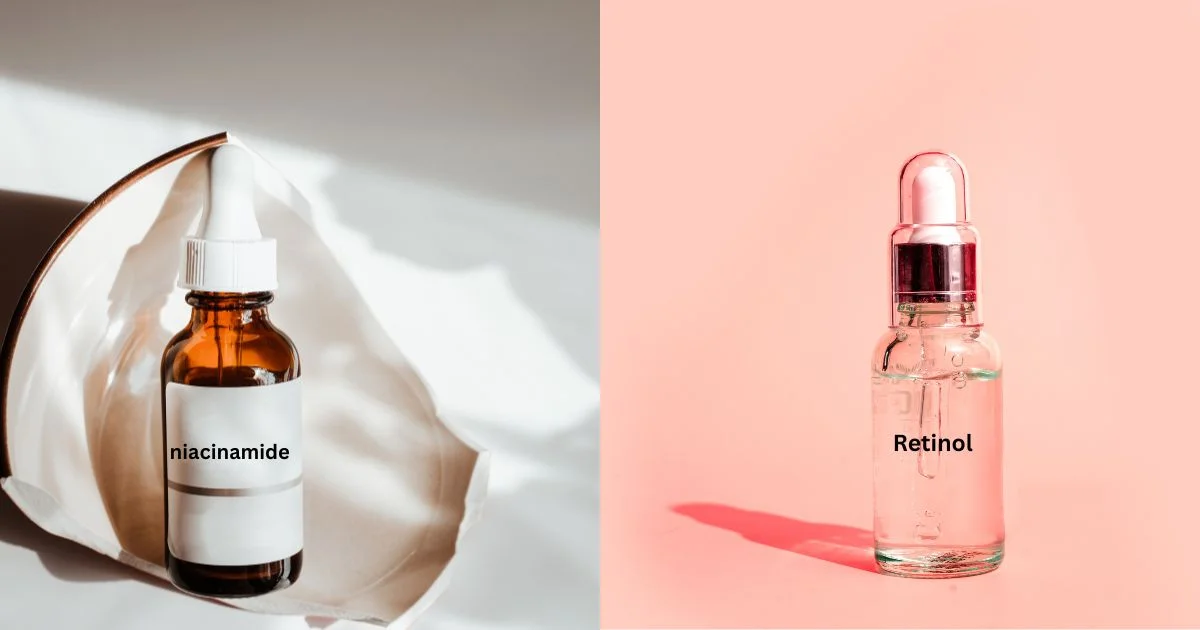Niacinamide and Retinol: The Dynamic Duo for Skincare
In the world of skincare, finding the perfect combination of ingredients to achieve healthy, radiant skin can be a daunting task. However, there are two powerhouse ingredients that have gained significant popularity in recent years: niacinamide and retinol. Both niacinamide and retinol offer a wide range of benefits for the skin, and when used together, they create a dynamic duo that can transform your skincare routine.
In this article, we will explore the individual benefits of niacinamide and retinol, their synergistic effects, and provide answers to frequently asked questions about these incredible ingredients.
 Niacinamide: Unveiling the Benefits
Niacinamide: Unveiling the Benefits
Niacinamide, also known as vitamin B3, is a water-soluble vitamin that offers numerous benefits for the skin. This versatile ingredient is suitable for all skin types and can address a variety of skincare concerns.
1.Promoting a Healthy Skin Barrier
One of the key benefits of niacinamide is its ability to strengthen the skin barrier. By enhancing the barrier function, niacinamide helps to lock in moisture, reduce transepidermal water loss, and protect the skin from environmental aggressors. This leads to improved hydration, reduced sensitivity, and a healthier complexion.
You may also like..Niacinamide and Glycolic Acid:10 effective benefits of the Power Duo for Skin Care Can Niacinamide and Salicylic Acid be used together? 10 Powerful benefits Glycolic Acid and Vitamin C for Radiant Skin
2.Minimizing Pore Appearance
Are enlarged pores a concern for you? Niacinamide can help. This remarkable ingredient has been shown to regulate sebum production, which can help minimize the appearance of pores. By controlling oil production, niacinamide keeps your skin looking fresh, smooth, and refined.
3.Brightening the Complexion
If you’re looking to achieve a more radiant complexion, niacinamide can be your ally. This multitasking ingredient inhibits the transfer of melanin, helping to fade dark spots, hyperpigmentation, and acne scars. Regular use of niacinamide can result in a more even skin tone and a brighter, glowing complexion.
4.Soothing Inflammation
Niacinamide possesses anti-inflammatory properties, making it an excellent choice for those with sensitive or acne-prone skin. It helps to calm redness, reduce irritation, and alleviate discomfort. Incorporating niacinamide into your skincare routine can lead to a calmer and more balanced complexion.
Retinol: The Youthful Elixir
Retinol, a derivative of vitamin A, is often hailed as the gold standard in anti-aging skincare. This powerhouse ingredient has the ability to transform the skin by targeting multiple signs of aging and promoting cellular turnover.
1.Smoothing Fine Lines and Wrinkles
Retinol’s most celebrated benefit is its remarkable ability to diminish the appearance of fine lines and wrinkles. By stimulating collagen production and increasing cell turnover, retinol helps to plump the skin, reducing the depth of wrinkles and fine lines. With consistent use, retinol can help you achieve a smoother and more youthful complexion.
2.Improving Skin Texture
Uneven skin texture, roughness, and dullness can make the skin appear aged and lackluster. Retinol comes to the rescue by promoting exfoliation and shedding dead skin cells, revealing a fresher, smoother surface underneath. The result is improved skin texture, a refined appearance, and a vibrant glow.
3.Fighting Acne and Blemishes
Retinol’s benefits extend beyond anti-aging. This powerful ingredient also possesses anti-acne properties, making it a valuable asset for those struggling with breakouts. Retinol unclogs pores, reduces sebum production, and promotes faster healing of acne lesions, leading to clearer, blemish-free skin.
4.Enhancing Skin Elasticity
Loss of elasticity is a common sign of aging, contributing to sagging skin and the formation of wrinkles. Retinol stimulates the production of elastin fibers, which are responsible for maintaining skin elasticity. By boosting elastin production, retinol helps to restore firmness and improve skin’s overall suppleness.
Niacinamide and Retinol: A Match Made in Skincare Heaven
While niacinamide and retinol offer a plethora of benefits individually, their combined use can produce even more remarkable results. These two ingredients work synergistically to enhance each other’s effectiveness, creating a powerful skincare combination.
Niacinamide’s soothing properties help to counteract the potential irritation caused by retinol. By reducing inflammation and promoting a balanced complexion, niacinamide ensures that the skin tolerates retinol more effectively. This is particularly beneficial for those with sensitive skin or those who are new to retinol.
Additionally, niacinamide complements retinol by providing antioxidant protection. This helps to neutralize free radicals and prevent oxidative damage, preserving the skin’s youthful appearance and maximizing the benefits of retinol.
Incorporating both niacinamide and retinol into your skincare routine can lead to a multitude of positive effects, including minimized pores, improved skin texture, diminished signs of aging, and a brighter complexion. To harness the power of this dynamic duo, consider using a niacinamide serum in the morning and a retinol treatment in the evening.
How to use “niacinamide and retinol” together
- Start with a Clean Face: Begin by cleansing your face thoroughly with a gentle cleanser suitable for your skin type. Pat your skin dry with a clean towel.
- Apply Niacinamide Serum: Take a few drops of a niacinamide serum and gently massage it onto your face and neck. Niacinamide serums are available in various concentrations, so choose one that suits your skin’s needs. Allow the serum to absorb fully into the skin.
- Moisturize: Follow up with a moisturizer that contains niacinamide as an ingredient. This will further enhance the benefits of niacinamide and provide hydration to your skin. Apply the moisturizer evenly over your face and neck, using gentle upward motions.
- Sunscreen Protection: It’s crucial to protect your skin from the sun’s harmful rays, especially when using retinol. Apply a broad-spectrum sunscreen with an SPF of 30 or higher as the final step in your morning skincare routine.
- Wait for the Evening: Niacinamide and retinol should be used separately due to their different pH levels. Therefore, reserve retinol for your evening skincare routine.
- Cleanse Again: Before applying retinol, cleanse your face to remove any traces of makeup, dirt, or sunscreen from the day. This will ensure that retinol penetrates the skin effectively.
- Apply Retinol: Take a pea-sized amount of retinol cream or serum and dot it onto your forehead, cheeks, chin, and neck. Gently massage the retinol into your skin using upward motions. Start with a low concentration and gradually increase as your skin adjusts to it.
- Moisturize Again: After allowing the retinol to absorb for a few minutes, apply a moisturizer to provide extra hydration and minimize potential dryness or irritation associated with retinol use.
- Consistency is Key: Both niacinamide and retinol require consistent use to see noticeable results. Incorporate them into your skincare routine regularly, but be mindful of any signs of irritation or sensitivity. If any discomfort occurs, reduce the frequency of use or consult a skincare professional.
Conclusion
Niacinamide and retinol are undoubtedly two of the most remarkable ingredients in skincare. Individually, they offer a wide range of benefits for the skin, from reducing wrinkles and fine lines to brightening the complexion and minimizing pore appearance. When used together, their synergistic effects are even more impressive, providing a comprehensive solution for various skincare concerns. Whether you’re looking to combat signs of aging or achieve a healthier complexion, incorporating niacinamide and retinol into your skincare routine can be a game-changer. Embrace the power of this dynamic duo and unlock the secrets to radiant, youthful skin.
Disclaimer: The information provided in this article is for educational purposes only and should not be considered as a substitute for professional medical advice or treatment. Always consult with a qualified healthcare provider before making any changes to your skincare routine.
FAQs
Can I use niacinamide and retinol together?
Yes, niacinamide and retinol can be used together. In fact, their combined use can lead to enhanced results, as they work synergistically to improve the overall health and appearance of the skin.
Should I use niacinamide and retinol every day?
It is generally recommended to introduce niacinamide and retinol into your skincare routine gradually. Start by using them a few times a week and gradually increase the frequency as your skin adjusts. If any irritation or sensitivity occurs, reduce the usage and consult with a skincare professional.
Can niacinamide and retinol be used in the same skincare routine?
Yes, niacinamide and retinol can be used in the same skincare routine. Apply niacinamide in the morning as a serum or moisturizer and retinol in the evening as a treatment. Always follow up with sunscreen during the day to protect your skin.
Can niacinamide and retinol cause skin irritation?
While niacinamide and retinol are generally well-tolerated, some individuals may experience mild irritation or sensitivity. This can be minimized by starting with lower concentrations and gradually increasing over time. If irritation persists, discontinue use and consult with a skincare professional.
Are there any side effects of using niacinamide and retinol?
Niacinamide and retinol are considered safe for most people when used as directed. However, some individuals may experience mild side effects such as redness, dryness, or flaking. These side effects are typically temporary and can be managed by adjusting the frequency or concentration of use.


 Niacinamide: Unveiling the Benefits
Niacinamide: Unveiling the Benefits

